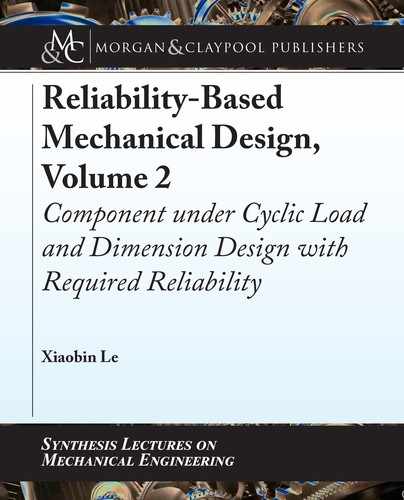
18 2. RELIABILITY OF A COMPONENT UNDER CYCLIC LOAD
fully reversed cyclic bending stress, determine the surface finish modification factor k
a
, the size
modification factor k
b
, and the load modification factor k
c
.
Solution:
e surface finish modification factor k
a
will be treated as a normally distributed random vari-
able. e mean
k
a
of the surface finish modification factor k
a
per Equation (2.14) is:
k
a
D 2:7
.
S
ut
/
0:2653
D 2:7.61:5/
0:2653
D 0:9053: (a)
e coefficient of variance of k
a
per Equation (2.15) is:
k
a
D 0:06: (b)
e standard deviation of k
a
per Equation (2.16) is
k
a
D
k
a
k
a
D 0:06 0:9053 D 0:0543: (c)
e size modification factor k
b
will be treated as a deterministic per Equation (2.17) is:
k
b
D
d
0:3
0:1133
D
1:5
0:3
0:1133
D 0:8333: (d)
e load modification factor k
c
is treated as a normal distributed random variable. Its mean
k
c
per Equation (2.18) is:
k
c
D 0:583: (e)
e coefficient of variance of
k
ac
per Equation (2.19) is:
k
c
D 0:123: (f)
e standard deviation of k
c
per Equation (2.20) is
k
c
D
k
c
k
c
D 0:123 0:583 D 0:0717: (g)
2.5 THE EFFECT OF MEAN STRESS
Fatigue strength data is typically from fatigue tests under a fully reversed cyclic stress. Even
when a fatigue test is under a non-zero-mean cyclic stress, it is typically presented as a fatigue
strength data with an equivalent stress amplitude of a fully reversed cyclic stress. is approach
is simply because general cyclic loading for mechanical component fatigue design might be any
non-zero-mean stress cyclic stress. ere are many fatigue theories such as Soderberg approach,
Modified Goodman approach, Gerber approach, and ASME-Elliptic approach for considering

2.5. THE EFFECT OF MEAN STRESS 19
the effect of mean stress [2, 5]. is book will use the Modified Goodman approach to consider
the effect of mean stress in cyclic stress through the following equation:
aeq
D
8
<
:
a
S
ut
S
ut
m
when
m
0
a
when
m
< 0;
(2.21)
where
a
and
m
are the stress amplitude and the mean stress of cyclic stress. In Equation (2.21),
S
ut
is the ultimate material strength as a deterministic value, which will be equal to the average
value of the ultimate material strength.
aeq
is the equivalent stress amplitude of a fully reversed
cyclic stress. For cyclic stress with negative mean stress, the equivalent stress amplitude will be
equal to the stress amplitude of the cyclic stress with negative mean stress because the compressed
mean stress will help to stop the crack propagation. erefore, the Modified Goodman approach
is more conservative.
Example 2.3
A component is subjected to cyclic stress with a mean stress
m
D 5 (ksi) and a stress ampli-
tude
a
D 17 (ksi). e ultimate material strength is 61.5 (ksi). Determine its equivalent stress
amplitude of a fully reversed cyclic stress.
Solution:
Per Equation (2.21), the equivalent stress amplitude in this example with a positive mean stress
m
D 5 (ksi) will be:
aeq
D
a
S
ut
S
ut
m
D 17
61:5
61:5 5
D 18:5 .ksi/:
Example 2.4
A fatigue test specimen is under cyclic stress with a mean stress
m
D 15 (ksi) and a stress
amplitude
a
D 15 (ksi). e fatigue life, that is, the number of cycles at failure under such cyclic
loading for this fatigue specimen is 6:5 10
5
(cycles). e ultimate strength of the material of
the specimen is 61.5 (ksi). Express this fatigue test data as a fatigue test data under a fully reversed
cyclic stress.
Solution:
Per Equation (2.21), the equivalent fatigue strength in this example with a positive mean stress
m
D 21 (ksi) will be:
S
0
f
D
aeq
D
a
S
ut
S
ut
m
D 21
61:5
61:5 21
D 31:89 .ksi/:
So, for this fatigue test, the fatigue test results could be equivalently expressed by:
..................Content has been hidden....................
You can't read the all page of ebook, please click here login for view all page.
